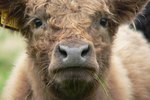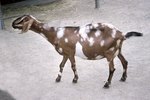More than 200 breeds of goats exist throughout the world, ranging in size from the small Nigerian dwarf to the massive Anglo-Nubian. Some of the differences between male and female goats are subtle enough that you may need to observe a side-by-side comparison of a male and a female of the same breed. Other differences can vary according to age and according to whether a male goat has been castrated. Luckily, evidence under the tail will let you determine the gender with certainty.
Size Differences and Scent
Most domestic goats range in weight from 20 to 250 pounds, depending on the breed. Average is about 100 pounds. Goat heights range between 10 and 43 inches at the shoulders; average is 25 inches. Regardless of breed, the male goats, called bucks, are larger than the females, which are called does. One characteristic that confirms a goat is a male is odor. During mating season, bucks emit a pungent musky scent. This odor from their sex glands acts as a pheromone to attract females to breed. If you take a whiff and the strong odor assails your nostrils, you know that you have a male goat who has not been castrated. Does and castrated males, or wethers, do not release these odors.
Beard and Horn Confusion
Trying to determine the gender of a goat by merely looking for the presence of a beard and horns will not necessarily provide the answer. Male goats have beards on their chins, but females can also grow goatees. The beard on a buck will grow longer and thicker than that of the doe. Male and female goats both have hollow horns. The horns of a buck grow longer and appear thicker than those of a doe. Some male and female goats are dehorned in order to prevent injury to the farmers and to one another. Some goats are genetically born without horns, a trait known as polled. This trait can occur in either gender.
Anatomical Structures
One gender-specific anatomical feature to look for is the udder of the milk-producing female. This can be seen extending from the lower abdomen between the rear legs. Females are not sexually mature until they are a year old, and they must become pregnant in order for the udder to enlarge as it fills with milk. On a buck, an elongated scrotal sac containing two testicles can be observed hanging between the rear legs. Males reach sexual maturity at 5 months, but they can be safely castrated as early as 10 weeks.
The Final Conclusive Answer
The final answer to the goat gender query can be observed on any goat of any age. The most accurate way to determine whether you have a male or female goat is to peek under the tail. A female goat has an anus and a second opening below the anus. This second opening is the vagina, which is the opening of the birth canal through which her kids are born. Since male goats do not give birth, they only have an anal opening and, below that, their reproductive organs.
References
- Smithsonian National Zoological Park: Kids’ Farm: Goats
- University of Michigan: Animal Diversity Web: Capra Hircus Domestic Goat
- San Diego Zoo: Animals: Mammals: Goat & Sheep
- Animal Corner: Goat Anatomy
- University of Arkansas: Cooperative Extension Program: Animal Science: Introduction to Goat Reproduction
- Cornell University: New York State 4-H Meat Goat Project Fact Sheet #10: All About Castrating and Urinary Calculi
Photo Credits
-
andyr1967/iStock/Getty Images




